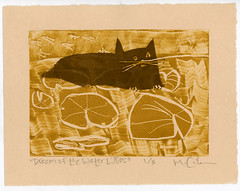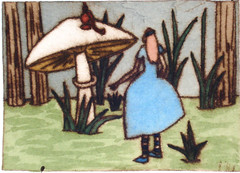
Websites
Flickr: flickr.com/photos/mmcullenart
Etsy: www.mmcullen.etsy.com
Brief Bio
I was born in 1966, before there were so many distractions competing for children’s attention. Drawing was important to me, so I never stopped. Most kids give up drawing at age 7 or so. For my undergraduate degree at the University of Wisconsin-Madison, I had two interests: art and writing. I cared too much about art to let educators work their full mischief on me, so I let them teach me how to write instead. I majored in English, with a minor in Art. It has always been important for me to try to keep art fun for myself. If my work somehow touches others along the way, that is a big bonus. I am thrilled when that happens.

How did you get started in printmaking?
Public school gave me an exposure to linoleum, woodblock, and drypoint. Later, I learned silk-screening, lithography, letterpress, and etching. I was repelled by lithography and copper plate etching, because it was too complicated. I prefer homegrown simplicity.
Describe where you work.
Sketching can take place anywhere. The preparation of the printing plate takes place at the humble kitchen table. To print, I head out to the Pine Bluff Studio, which features an expansive view of undulating woodlands and cornfields. The topography is hilly, and outcroppings of limestone cliffs punctuate the landscape. Glaciers did that eons ago. A friend and I have a Conrad Etching Press out there.

What's your favorite printmaking process?
If I had to choose, I would say I like the acetate drypoint etchings best. Linocuts are bold and graphic, but the etchings have a wispy, ephemeral quality that I find intriguing. Also, no two prints are the same, because it is impossible to remove the ink uniformly. The little smudges and chatter are so endearing and accidental.
What's your creative process for any given print? (e.g. sketch first? Pre-planned or free-form?)
I like to sketch. Sometimes, I feel the pencil just moves and I am a conduit for those impulses. It feels good to just let it all go. I even surprise myself at what comes out. Some of it is half-baked or rubbish--at least I think so--because occasionally, folks will really gravitate towards something I dismissed as unworthy. Even so, I have to be a curator. Although I would like to, I simply do not have time to make an edition out of everything. So many sketches never make it to print. When I find an image I want to pursue, I commit to it, prepare the plate, and make the 10-mile trek to Pine Bluff. When they are dry, I hand-paint them with watercolor. Or not. Sometimes, a print calls very loudly to be monochromatic. Conversely, monotype is fun because it is all Pine Bluff and very spontaneous.

What do you enjoy most about printmaking?
I like being able to give them away, sell them, or stow them in boxes. Multiples make that much more likely to happen. I tend to be possessive about paintings on canvas or items that are one-of-a-kind. Prints are much more affordable than a painting, and wall space is serious real estate for most people. Printmaking seems more democratic somehow. Printmaking is a gateway drug.
What's your least favorite part of the process?
Cleaning up after the printing is complete. Somewhere there is a guy who has other people do that for him. You know there is. Even though I do not like putting away my toys, I would not want to be that guy. That seems dangerously self-important.
What are your inspirations (other artists, people, places, events, etc.)?
I lived in Japan as an English teacher for a year. Without a doubt, that has been (and continues to be) a guiding light. It was such a privilege to drift through the floating world for a year. I am inspired by children’s artwork, animation, cartoons, Matisse, Modigliani, and of course, Japanese art.

How has your work changed and evolved since you started?
One day, my employer and I were discussing some etchings that I had done in a class. I was complaining about the chemicals, and how complicated it was. He recalled that during his childhood, elementary school art teachers used acetate to teach the rudiments of drypoint etching to kids. That conversation was a turning point for me. Owning the Cadillac of printing presses has also changed my work. It is such a luxury to run an edition of prints on the dream-machine.
How do you get past creative slumps?
One method is to get together with another visual artist. Solitude can become a very tight loop. Getting input from someone else is a great way to break through slumps. Collaborative art is fun because you have to let go of preconceptions. Try as you might, you are no longer in control. It also forces you to consider other options, and to think outside your own little box. New ideas come crashing in, and I spin off in new directions.

How do you promote your work?
This is an area that I am admittedly weak at. I am really attracted to making art, and not as concerned about promoting it. Sales have happened over the years, and I was published in a magazine with national distribution. I even made it into the collections at a couple museums and art libraries, but it has been more kismet than an active pursuit. The advent of the Internet has made networking a lot easier, and I dabble at making myself visible. Esty is wonderful to me, because people manage to find my work simply by cruising and roaming about. This is going to sound naïve and Betty Crocker, but I think I prefer it that way. It is exciting and fun to imagine how they arrived at making their purchase. I am less interested in herding people. I like the idea of free-range patrons of the arts.
Any other comments or advice for others who want to try making hand-pulled prints?
Stay open, and try new things. Destinations are over-rated. Your journey is the real story. The artworks are merely signposts along the way.
2 comments:
My grandmother always said that if you didn't clean up the mess, your baking would never turn out. I think the same thing must hold for printmaking. ;)
Another interesting interview - I enjoy how each print looks like it illustrates some unknown story.
I like the bright qualities of your work. I think children would love them very much - as do I.
Post a Comment